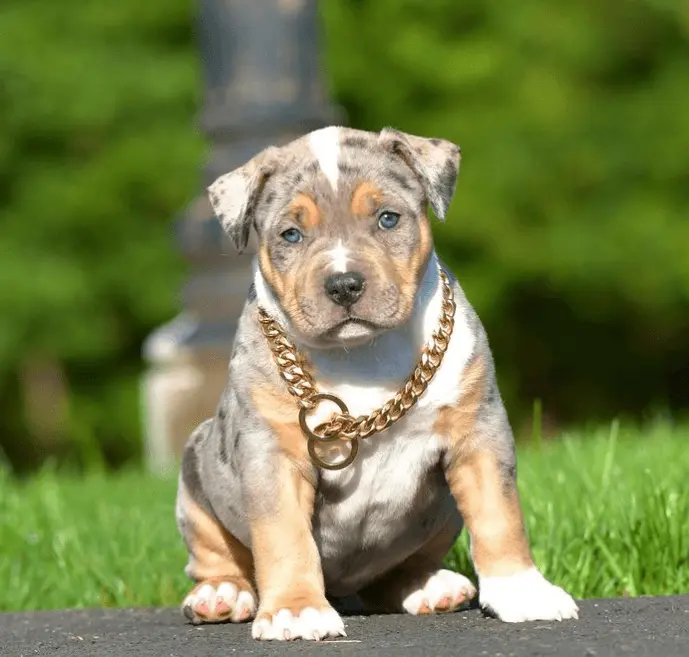Photo: https://www.instagram.com/p/Cwx-QhqvJIQ/
Are you looking to add a unique pup to the family? You might be interested in the American Bully breed, which is known for its noble and affectionate personality and physical appearance. The tri color Blue Bully is one such breed that specifically stands out with its rare coat pattern—beautiful blue brindled markings blended against an all-white background. Read on for more information about what makes this breed so lovable.
Overview of the Tri Color Blue Bully
We discussed the tri color bullies as a breed in our earlier post. Today, we dive into the tri color Blue Bully. The tri color Blue Bully is a distinct variant of the American Staffordshire Terrier and is renowned for its uniquely colored coats. The breed’s solid color fur, typically black, is highlighted by vibrant tan points – a result of the recessive tan point gene. Rather than the merle gene, dilution genes contribute to these color patterns. This breed, often confused with mixed breeds, offers a fascinating study to kennel clubs and breeders due to its unique color combinations.
Appearance, Temperament, and Characteristic Traits
Physical attributes of the tri color Blue Bully include a muscular and robust build, a staple characteristic of the American Bully breed. The unique black and tan distinguishes this breed from other Bully breeds. Despite the seemingly intimidating physique, the Blue Bully is gentle and friendly.
A notable trait of the Blue Bully is its inherent loyalty and affection towards its family. This breed is known for its intelligence, making it highly responsive to commands and easy to train. Its sociable nature makes it a great companion for both children and adults.
Dietary Needs
Like other dogs, you should feed your tri color Blue Bully a balanced diet of nutritious, high-quality dog food. Monitor the amount of food because the bullies have a propensity towards obesity. Ensure that the diet includes necessary nutrients such as proteins, carbohydrates, fats, vitamins, and minerals to maintain their muscular body and energy levels. While the breed does not have any known specific dietary restrictions, it is always best to consult with a vet to address any individual nutritional needs.
Exercise Needs
Regular exercise is crucial for the Blue Bully to maintain its robust physique and for its mental stimulation. Set aside a few hours a day for playtime and walks. Bullies also benefit from mental stimulation activities like obedience training or agility courses, which keep them healthy and happy.
Training
Blue Bullies are intelligent and eager to please their owners. Therefore, they are relatively easy to train. Early socialization and positive reinforcement techniques are particularly effective with this breed. Training should focus on commands, behavioral patterns, and social interaction to ensure a well-behaved and sociable dog.
It’s essential to understand that every tri color Blue Bully is unique and may not fit this exact descriptive mold. Their traits may vary based on their upbringing, training, and individual temperament.
Grooming Needs
The Blue Bully has a short, glossy coat that is relatively easy to maintain. However, regular grooming is still necessary to keep their unique coats in the best condition. Grooming requirements include weekly brushing to remove loose hair and distribute natural skin oils. This helps maintain the coat’s health and shine. Although bullies are not heavy shedders, shedding may increase seasonally, necessitating more frequent brushing.
Blue bullies should bathe as needed since over-bathing can lead to skin issues due to the stripping of natural oils. Use a gentle, dog-appropriate shampoo to prevent skin irritation. Regular ear checks for signs of infection, such as redness or unusual odor, are also necessary. Brush their teeth regularly to avoid dental problems, and occasionally add coconut oil to their food as it helps with teeth. Remember to trim their nails monthly or when need be,
Grooming presents an excellent opportunity to check for any skin abnormalities such as bumps, rashes, or signs of parasites. Regular grooming sessions not only contribute to the physical well-being of the tri color Blue Bully but also serve as a bonding time between the owner and the dog. Consult with a professional groomer or a vet for any specific grooming requirements.
Health Concerns for the Tri Color Blue Bully
While the unique coloration of these rare bullies is desirable, it can sometimes lead to health issues. Therefore, it is important to buy your blue bully from breeders who practice ethical breeding.
One of the health implications associated with color genes in dogs, like the tri color Blue Bully, revolves around the dilution gene. This gene, responsible for the lightening of a dog’s coat color, can sometimes lead to a condition known as Color Dilution Alopecia (CDA). CDA is a genetic disorder that causes some hairs, particularly those with diluted pigment, to become brittle and break off. Thus leading to patchy hair loss and skin inflammation.
Another health issue relates to the melanocyte, the cell responsible for producing melanin. In dogs with particularly rich colors, there can be an overproduction of melanocytes. This could lead to a condition called Melanoma. While this is less common in the Blue Bully, it is a potential risk.
The third health implication is deafness. Dogs with the piebald or merle gene, which can cause patches of white fur and skin, are predisposed to congenital deafness. This is due to the lack of pigment-producing cells in the inner ear, which are crucial for normal hearing. Although the Merle gene is not directly involved in the color patterns of the Blue Bully, it’s essential to be aware of this risk when considering other breeds or mixed breeds.
Lastly, skin cancer is a potential risk associated with color genes. In some instances, dogs with lighter-colored coats are more susceptible to sun damage. Over time, this exposure can lead to skin cancer. Therefore, it’s essential to provide ample sun protection for these dogs to mitigate this risk.
These health implications highlight the importance of ethical breeding practices. Breeders should be aware of these potential health risks when striving for specific coat colors. Ethical breeding ensures the health and well-being of the dogs are not compromised for aesthetic reasons. For more in-depth information, refer to this scientific paper discussing the potential health implications of color genes in dogs.
Managing These Health Complications
For dog owners with a tri color Blue Bully, managing potential health complications begins with regular veterinary check-ups. These check-ups can help early detection of conditions like Color Dilution Alopecia (CDA), or Melanoma, giving your pet a better chance at effective treatment.
It’s crucial to protect your Blue Bully from excessive sun exposure, especially if they have a light-colored coat. Use dog-friendly sunscreens or provide shaded areas for them when outside during peak sun hours to prevent skin damage, which might lead to skin cancer.
Hearing tests should be conducted on puppies, especially if they come from a mixed breed lineage with piebald or merle genes. Early detection of congenital deafness will allow you to adapt your training methods to cater to your dog’s needs.
Maintain a balanced diet and regular exercise routine to keep your tri color Blue Bully healthy. Obesity can exacerbate many health issues, so monitoring food intake and ensuring your dog gets enough physical activity is critical.
Lastly, if you’re getting a tri color Blue Bully from a breeder, ensure they’re reputable and prioritize ethical breeding practices. Breeders should be aware of the potential health risks associated with coat color genes and strive to maintain the breed’s health over aesthetic preferences. Ethical breeders should willingly discuss any health implications and how they’re addressing them.
Cost Considerations When Buying a Blue Bully
When planning to welcome a tri color Blue bully into your home, it’s essential to consider the associated costs. These dogs are rare and sought-after, often demanding a higher price tag than other dog breeds or even other bullies with less unique colorations.
The cost can vary dramatically depending on the breeder, the puppy’s lineage, and the rarity of the coat color. On average, you can expect to pay between $2000 and $5000 for a Tri Color Blue Bully puppy from a reputable breeder. Some high-end breeders who specialize in this unique coloring may charge upwards of $10000, especially if the puppy has a particularly desirable genetic lineage.
The cost of owning an adult tri color Blue Bully is not just a one-time purchase price. There are ongoing costs associated with owning any dog, including food, vet bills, grooming, and pet insurance. These can add up to around $1000 to $2000 per year. It’s also worth noting that due to potential health issues associated with their unique color genes, tri color Blue Bullies may incur higher veterinary costs than other breeds.
It’s important to remember that while the unique coloring of the Blue Bully can be visually appealing, potential owners should prioritize the dog’s health and well-being over aesthetic considerations. Make sure you are ready for the financial commitment that comes with owning and caring for these unique and wonderful dogs.
The Tri Color Blue Bully: More Than Just a Colored American Bully
The tri color Blue Bully is not merely another American Bully breed. Its unique color combinations, friendly character make it a standout breed among kennel clubs and dog enthusiasts.





